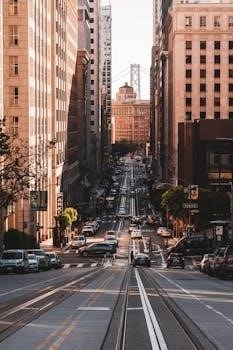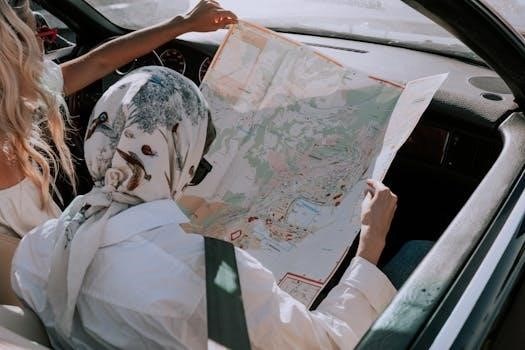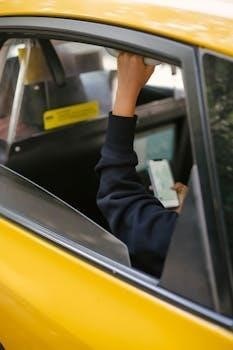san francisco cable car map pdf
San Francisco’s iconic cable cars, a symbol of the city, offer a unique and nostalgic way to explore. These historic vehicles traverse steep hills, providing scenic views and a memorable experience for visitors. They are a must for any trip to San Francisco.
Symbolism and History of Cable Cars in San Francisco
Cable cars are more than just a mode of transport; they represent San Francisco’s innovative spirit and rich history. Invented in 1873 by Andrew Hallidie, they were a solution to the city’s steep hills. They quickly became an iconic symbol, representing ingenuity and a unique part of the urban landscape. Initially, numerous routes crisscrossed the city, but now only three remain, preserving a piece of the past. These cable cars are a vital part of San Francisco’s cultural heritage, offering both residents and tourists an unforgettable experience. They are a testament to the city’s early innovation and continue to charm visitors with their timeless appeal. The cable car is as emblematic of San Francisco as the Golden Gate Bridge.

Cable Car Routes Overview
San Francisco’s cable car system features three distinct routes, each offering unique views and access to different neighborhoods. These lines provide a scenic and historic way to navigate the city.
The Three Main Cable Car Lines in San Francisco
San Francisco’s cable car system is comprised of three main lines, each providing a unique experience and route through the city’s diverse neighborhoods. The Powell-Hyde line is famous for its scenic route, including a portion that goes down the steep hill on Hyde Street, near Lombard Street. The Powell-Mason line takes you through the bustling areas towards Fisherman’s Wharf. Finally, the California Street line is used by commuters, and it climbs Nob Hill and goes to Van Ness Avenue. These three lines offer a historic and charming way to see San Francisco, and are not to be confused with San Francisco’s streetcar lines. Each line provides access to many popular destinations.
Powell-Hyde Line (Line 60)
The Powell-Hyde line, designated as Line 60, is one of the most popular cable car routes in San Francisco. It starts near Union Square at Powell and Market Streets, and it travels through Nob Hill and Russian Hill before making its way down a steep grade on Hyde Street. This route offers breathtaking views of the city, including a glimpse of the famed Lombard Street. It then terminates close to the waterfront at the San Francisco Maritime Museum and Ghirardelli Square, making it a great option for visitors heading to Fisherman’s Wharf. The Powell-Hyde line is a must-do for those wanting to experience the true charm of the city.
Powell-Mason Line
The Powell-Mason line is another of San Francisco’s iconic cable car routes, also starting at the bustling intersection of Powell and Market Streets. This line takes a different path than the Powell-Hyde, ascending Nob Hill and then heading towards Bay Street near Fisherman’s Wharf. It’s a great choice for those looking to explore the northern parts of the city, offering a scenic ride through some of San Francisco’s most charming neighborhoods. The Powell-Mason line provides access to various attractions and is a convenient and enjoyable way to get around. This makes it a popular choice for both tourists and locals.
California Street Line
The California Street Line is the third of San Francisco’s three operating cable car routes, distinguishing itself from the other two by its east-west trajectory. This line starts near the Embarcadero at Market Street and climbs up through Nob Hill, passing by several upscale hotels and offering stunning views. It then continues down to Van Ness Avenue, nearing the Civic Center. This route is particularly notable for being used by commuters, as it is very practical. Unlike the Powell lines, this line does not directly connect to Fisherman’s Wharf, providing a different experience.

Route Details and Landmarks
San Francisco’s cable car routes showcase diverse areas, from the Financial District to Nob Hill and Chinatown. Each line offers unique views and access to key landmarks, enhancing the travel experience.
Areas Covered by Cable Cars⁚ Financial District, Nob Hill, Chinatown, etc.
San Francisco’s cable cars provide access to a variety of vibrant neighborhoods, each with its own distinct character. The Financial District, with its towering skyscrapers, is a bustling hub of commerce. Nob Hill, known for its grand hotels and elegant architecture, offers a glimpse into the city’s historic past. Chinatown, one of the oldest in North America, is a cultural treasure trove of markets and restaurants. Cable cars also serve areas like Little Italy, North Beach, and Russian Hill, each contributing to San Francisco’s rich tapestry. These routes allow visitors to experience the city’s diverse and iconic landscapes.
Specific Stops and Turnarounds on Each Line
Each of the three San Francisco cable car lines has distinct stops and turnaround points. The Powell-Hyde and Powell-Mason lines both originate near Union Square at Powell and Market Streets, utilizing a turntable system for direction changes. The Powell-Hyde line terminates near Ghirardelli Square at Hyde and Beach, while the Powell-Mason line concludes at Bay Street near Fisherman’s Wharf. The California Street line runs from Market Street near the Embarcadero to Van Ness Avenue, with its own turnarounds at each end. These specific stops are crucial for navigating the city and provide access to key attractions along each route.
Lombard Street and the Powell-Hyde Line
The Powell-Hyde cable car line offers a unique opportunity to experience one of San Francisco’s most famous landmarks⁚ Lombard Street. This line travels along Hyde Street, passing near the top of the “most crooked street in the world.” While the cable car doesn’t directly traverse the winding section of Lombard, it provides a convenient way to access the area. Passengers can disembark near the top of Lombard, then walk down to admire its unique design and capture memorable photos. The Powell-Hyde line makes it easy to experience this iconic San Francisco attraction.

Practical Information for Riding Cable Cars
Riding the cable cars requires purchasing tickets or passes, which can be done at kiosks or via mobile apps. Knowing where to board and the operating hours ensures a smooth ride.
Ticketing and Payment Options (Single Tickets, Passes)
Riding San Francisco’s cable cars requires a valid ticket or pass. Single ride tickets are available for purchase, ideal for those taking a short trip or just wanting to experience one ride. For frequent riders or those planning to explore multiple lines, day passes or multi-day passes offer a more cost-effective solution. These passes allow unlimited rides within the specified time frame. Tickets can be purchased at designated kiosks near the cable car turnarounds, or through the MuniMobile app. Clipper cards, a regional transit payment card, are also accepted. Transfers from other Muni services are not valid on cable cars. Always be sure to have your ticket or pass ready before boarding to ensure a smooth experience.
Where to Board Cable Cars
Boarding a San Francisco cable car is part of the adventure. The most common boarding points are at the cable car turntables, located at the beginning or end of each line. These turntables are easily identifiable and often have queues of people waiting to ride. The Powell and Market Street intersection is a major hub, where the Powell-Hyde and Powell-Mason lines originate. You can also board at designated stops along the routes, identifiable by brown-and-white signs. Be aware that during peak hours, lines can be long, so it is wise to plan accordingly. Also, pay attention to the direction of the car to ensure you are heading in the right way. Wait for the car to come to a complete stop and allow passengers to disembark before attempting to board.
Operating Hours of the Cable Cars
San Francisco’s cable cars operate daily, generally from 8 a.m. to 8 p.m. However, it’s important to note that operating hours can vary slightly depending on the specific line and the time of year. It’s always a good idea to check the official San Francisco Municipal Transportation Agency (Muni) website or app for the most up-to-date schedule before your visit. Keep in mind that the last car of the day might depart a bit earlier than the closing time, so plan your ride accordingly. During holidays or special events, there might be changes to the operating hours, so it’s best to double-check if you’re traveling during those times to avoid disappointment. The cable cars offer a great experience, but knowing the schedule will help you make the most of your ride.
Distinguishing Cable Cars from Streetcars
Cable cars are distinct from streetcars, running on tracks connected to a moving cable beneath the street. Streetcars, on the other hand, are powered by electricity, making them different systems.
The Difference Between Cable Cars and Streetcars
Often confused, San Francisco’s cable cars and streetcars are fundamentally different. Cable cars are unique, relying on a continuously moving underground cable. They grip this cable to ascend hills, making them a rare, historical system. Streetcars, however, operate on standard electric power, drawing energy from overhead lines. They are part of a separate network and use different technology. While both contribute to the city’s charm, cable cars are a distinct San Francisco experience, not to be mistaken for the more common streetcar.

Additional Resources
For further information, downloadable maps of cable car routes are available on the Market Street Railway site. Additionally, the Cable Car Museum offers a deeper look into their history and operation.
Downloadable Maps of Cable Car Routes
Planning your San Francisco cable car adventure is made easier with downloadable maps readily available online. These maps, often found on the Market Street Railway website or other related travel resources, provide a clear visual guide to the three cable car routes. They detail the paths of the Powell-Hyde, Powell-Mason, and California Street lines, allowing you to understand where each line travels and which landmarks it passes. Having a downloadable map on your phone or printed out will help you navigate the city efficiently and ensure you don’t miss any key sights along your chosen route. These resources are invaluable for both first-time visitors and returning tourists who want to explore San Francisco’s iconic cable car system.
Cable Car Museum
The San Francisco Cable Car Museum, located at 1201 Mason Street, offers a fascinating look into the history and mechanics of the city’s iconic cable car system. It showcases the intricate machinery that powers the cable cars, including the massive winding wheels and cables themselves. Visitors can explore exhibits detailing the evolution of the cable car, from its invention in 1873 to its current operation. The museum also features historical photographs and artifacts, providing context to the system’s role in San Francisco’s past and present. A visit to the Cable Car Museum is an enriching experience for anyone wanting to understand the inner workings of these beloved vehicles.
Leave a Reply